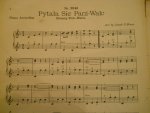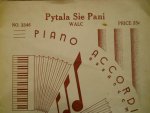V
VintageIorio
Guest
This is the song I'm trying to learn. It is from about 1935. This sheet music is written with two treble clefs instead of treble and bass. I'm wondering if at some point in time the switch was made to print music like piano music with a treble clef for the right hand and a bass clef for the left hand.
I always had trouble reading bass clef. Treble clef was easy with F A C E and Every Good Boy Does Fine. That's the way I learned it and maybe it's even true. I was a good boy (well, pretty good) and I did fine (mostly fine).
Still today, whenever I try to read the bass clef I have to imagine the treble clef and then bump up the notes from one line to the one above or from one space to the space above. So if it looks like A on the bass clef it must really be a C. etc.
If all printed music was written with 2 treble clefs it would be easier for me. Probably not easier for others.
I'm just curious. I have another piece of music from the same era and the notation is the same.
Thanks for reading.
--Loren
I always had trouble reading bass clef. Treble clef was easy with F A C E and Every Good Boy Does Fine. That's the way I learned it and maybe it's even true. I was a good boy (well, pretty good) and I did fine (mostly fine).
Still today, whenever I try to read the bass clef I have to imagine the treble clef and then bump up the notes from one line to the one above or from one space to the space above. So if it looks like A on the bass clef it must really be a C. etc.
If all printed music was written with 2 treble clefs it would be easier for me. Probably not easier for others.
I'm just curious. I have another piece of music from the same era and the notation is the same.
Thanks for reading.
--Loren


